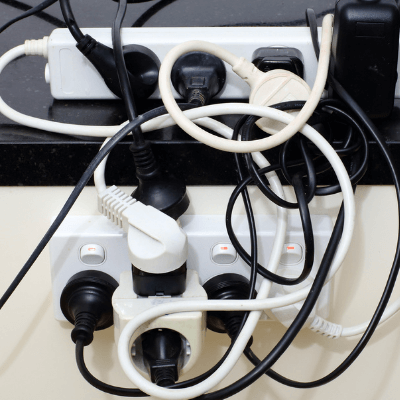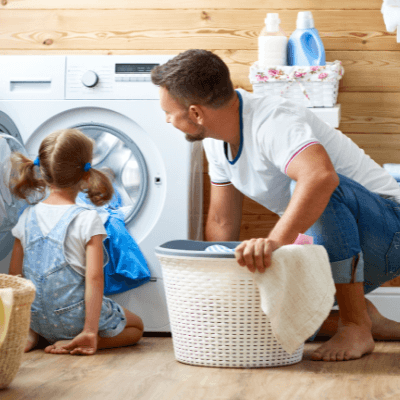Fire safety at home: your room by room guide
- There are thousands of house fires every year in Australia
- Every room has its risks, many of which we may not be aware of
- By taking small proactive steps, you can reduce fire risk in your home
A fire burning through your home certainly falls into the ‘worst nightmare’ category. Accidental fires impact around 4,500 homes each year in NSW alone.1
While property and possessions can usually be replaced, sentimental items and, most importantly, lives can’t.
A proactive approach to home fire prevention
By being aware of the risks that are around us every day, we can make our homes safer for everyone. Overall, remember to:
- Test your smoke alarms regularly to ensure they’re in working order. Regulations differ from state to state, but if your smoke alarm is battery-powered, an easy way to remember is to change the batteries when the clocks change.
- Invest in fire extinguishers and blankets and place them between a fire hazard and an exit.
- Create a fire escape plan to ensure everyone in the home knows what to do if the worst happens.
- A significant number of house fires (40% in NSW, for example) are caused by electrical faults and appliances.2 Get your wiring checked by a professional, particularly if you notice signs such as flickering lights, power tripping, or charring around power points.3
- Understand your level of bushfire risk and consider safety upgrades if you have an older home in a high-risk zone.
Almost half of all residential fires start in the kitchen, so it’s a good idea to start here.4
The kitchen

It’s the heartbeat of many homes, but in the kitchen, some fire risks are in plain sight.
When cooking:
- As tempting as it is (and almost three out of four of us do it)5, never leave cooking unattended – it only takes a moment for something to happen.
- Always choose the right size saucepan to help avoid fat splatters, which could cause burns and fires.
- Always turn handles of pots and pans inward to help prevent them from being knocked over.
- Don’t wear loose-fitting sleeves when cooking or leave tea towels and oven mitts near the cooktop – they can easily catch fire.
- Clean the grill and the rangehood regularly – a build-up of grease could ignite.
- Get your gas hob checked regularly by a licenced gasfitter.
- Only ever use microwave-safe utensils and containers – anything metallic could spark and cause a fire.
- A lot of recycled paper towels have small metal flecks, so only use paper towels that state they’re safe for microwave use.
- If you have a microwave fire, turn it off, unplug it if possible, and keep the door closed until the fire is out.6
Kitchen appliances
- Never run the dishwasher if you’re leaving the house or going to bed – old or faulty heating elements can cause a fire.
- An overheated compressor in a fridge could cause a fire if it can’t vent correctly. Newer and higher-spec fridges should have a metal backing as a heat shield, but older and lower-spec fridges may not.7 Switch off your fridge immediately if you suspect there’s a problem and call in a professional.
- Remove crumbs from the bottom of the toaster regularly to minimise the risk of fire.8
- Slow cookers have been known to cause fires, while the heating element on a coffee machine can also start a fire if the thermostat jams.9
The bedroom

We all want a solid night’s sleep, so here’s a few tips to reduce the risk of an unwanted fire.
- Wheat bags can dry out and become combustible, so only use them for their intended purpose – to relieve pain. Never sleep with a wheat bag and don’t reheat it until it’s completely cooled.10
- Don’t charge a device in or by your bed. A QBE survey polling 1,000 Australians in 2023 found more than 50% of Australian are guilty of it11, yet poor ventilation can result in your bed going up in flames.
- Most fires occur in old or worn electric blankets that are misused (for example, used when wet or folded12). Fires have also started when electric blankets have been left on all night or during the day, so remember to turn them off.
- Candles in the bedroom can be a great mood enhancer, but make sure they’re put out before you nod off. While a fire can take hold in just three minutes, it takes seconds to put out a flame.13
- Don’t smoke in bed. If you fall asleep with a cigarette burning, it could set your bedding alight.
The living room and office

The home’s a busy place – particularly if you work from home. Take a moment to assess the everyday risks that could be right under your nose.
- With multiple devices, we often have too many plugs and not enough sockets. While power boards can offer extra capacity, it’s important not to plug adaptors into them as it can cause an overload, resulting in a fire risk. Fire services recommend only using power boards with built-in safety switches.14
- QBE research suggests 44% of us leave our laptops and phones plugged in when we leave the house, and almost 50% leave our computers plugged in.15 Laptops usually have vents on the bottom or side, and if the laptop is left on a soft surface, it can block those vents and overheat.16
- A log fire is wonderful but needs careful management. Always have your chimney cleaned once a year to reduce the risk of chimney fires,17 use a fire screen, and keep wood at least a metre away from the fireplace.18
- During the cooler months, drying clothes can be a challenge. But putting clothes too close to heaters can cause your favourite jumper to go up in smoke. Never place clothes or towels directly on a heater – keep them at least a metre away.19
- Portable heaters need to be checked regularly to ensure they’re safe to use. Watch out for rusted reflectors and damaged power cords on electric heaters, and keep an eye on yellow flames on gas heaters. It’s important to get these appliances serviced by a qualified electrician or gas fitter.20 Make sure your heater is away from curtains, and can’t be knocked over, especially by children or pets.
The bathroom and laundry

They may not seem like prime fire-starting rooms, but the bathroom and laundry have their own risks.
- One of the major bathroom fire risks comes from heaters. It’s a good idea to clean the fan regularly to avoid lint collecting, overheating, and potentially causing sparks to fly.
- Canisters – for example deodorant or hairspray – should be kept out of direct sunlight,22 along with mirrors.23
- Hairdryers, straighteners and curling wands can all cause fires. They get extremely hot, so remember to turn them off and let them cool on a heatproof surface.
- In the laundry, dryers are a particular risk. According to research from QBE,24 28% of us often or occasionally leave our tumble dryer going when we leave the house. This can be a fire risk, given that 61% of us don’t clean our lint filters regularly.25 The lint produced can become a fire hazard, as it can cause overheating.
The outdoors
- Barbeques are a part of Australian life. But they need to be fired up responsibly. Always check hoses and connections for blockages and wear and tear, and cook on a flat base sheltered from wind.26 Keep it clean too.
- Store flammable materials – such as petrol, kerosene and methylated spirits – away from heat sources.
- While leaves and debris in gutters, and trees close to the property may not necessarily start a fire, if one starts, they can help it spread quickly. Clean gutters regularly, and keep trees trimmed back and leaves swept up.
- If you have a fire pit, ensure it’s at least 2.5m away from vegetation, a structure or combustible materials, and placed on a solid surface. Never leave it unattended, and always extinguish it with water.27
Bushfire Attack Levels: do you know yours?
Bushfires pose a significant risk to homes in many areas of Australia, so it’s important to understand if you are in a bushfire zone and know your home’s Bushfire Attack Level (BAL), especially if you have an older home.
- Older homes (40-60+ years old) are more vulnerable to fire because they haven’t been built in line with modern, more stringent building requirements. If you’re in an attack zone, upgrading your home in line with newer building measures, with the help of a qualified builder or fire safety professional, could lower your home’s risk.
- If your home is in a bushfire zone, make sure your sum insured includes the cost of bushfire protection measures, which you’d need to implement when rebuilding your home. The requirements and costs will vary depending on your home’s BAL.
Despite taking preventative measures, you can never eliminate the risk of a fire in your home. But the right level of home and contents insurance can provide protection and help get you back on your feet if the worst happens.
Learn about QBE home and contents insurance.
To decide if a product is right for you, please read the relevant Product Disclosure Statement (PDS) and Target Market Determination (TMD).
1 Common Fires | DEM Fire | Fire and Essential Services
2 Electrical safety in the home | NSW Government
3 Kitchen fire safety | Fire and Rescue NSW
4 Kitchen fire safety | Fire and Rescue NSW
5 Polling study of 1,001 Australians aged 18+, completed for QBE Insurance Australia in June 2023.
6 Microwave oven fire safety | Fire and Rescue NSW
7 Exploding Refrigerator? A Hidden Danger in Your Home – realtor.com.au
8 Indoor fire safety | Queensland Fire Department
9 Indoor fire safety | Queensland Fire Department
10 Wheat filled heat packs | Fire and Rescue NSW
11 Polling study of 1,001 Australians aged 18+, completed for QBE Insurance Australia in June 2023.
12 Electric Blankets | Metropolitan Fire Service
13 Be safe with candles | Fire and Rescue NSW
14 Electrical Power Boards | Fire and Rescue NSW
15 Polling study of 1,011 Australians, aged 18-65, completed for QBE Insurance Australia in April 2021
16 Why Can't You Leave a Laptop Plugged in and Sitting on the Bed or a Carpet? Chron
17 Wood smoke flyer | NSW EPA
18 Winter Fire Safety Checklist | Fire and Rescue NSW
19 Winter health hazards at home | healthdirect
20 Winter health hazards at home | healthdirect
21 What to do if your clothes catch fire | Metropolitan Fire Service
22 Safety in the Home | Aerosol Association of Australia
23 Can sunlight through glass objects really cause house fires? Science Focus
24 Polling study of 1,011 Australians, aged 18-65, completed for QBE Insurance Australia in April 2021
25 Polling study of 1,011 Australians, aged 18-65, completed for QBE Insurance Australia in April 2021
26 Barbeque fire safety | Fire and Rescue NSW
27 Backyard burning, braziers and fire pits | Brisbane City Council










